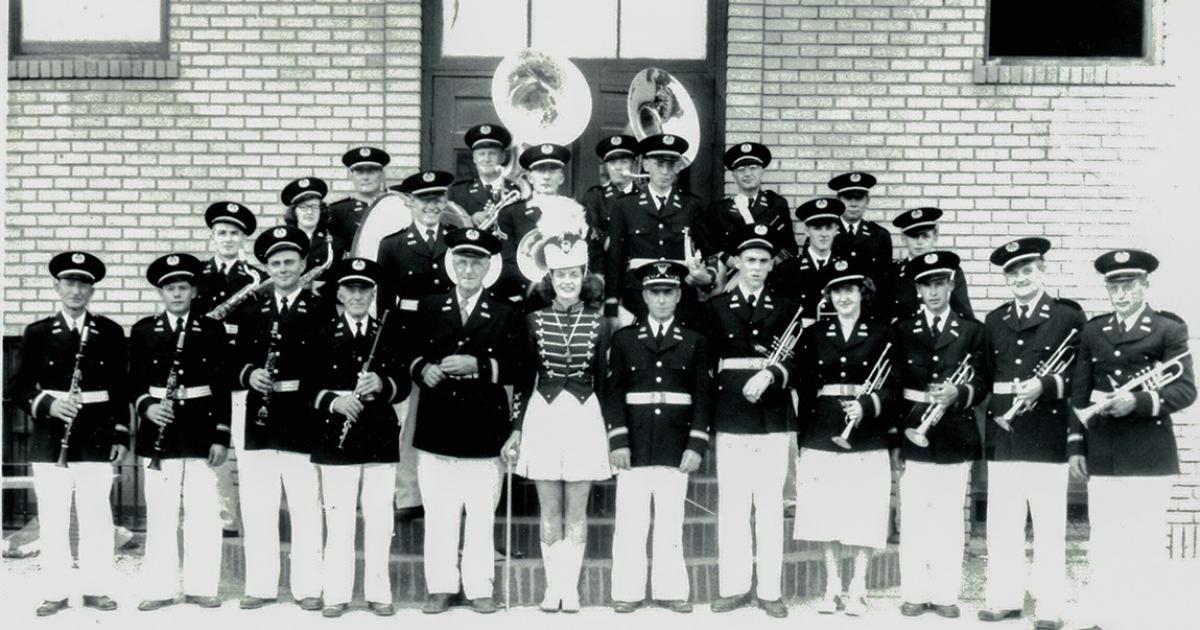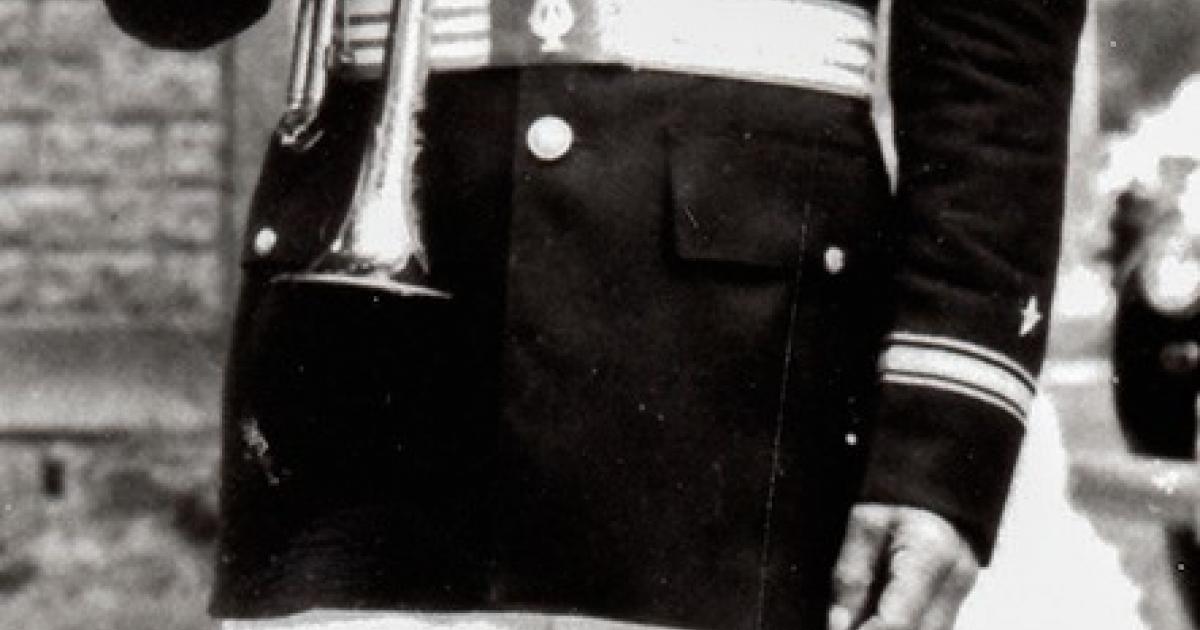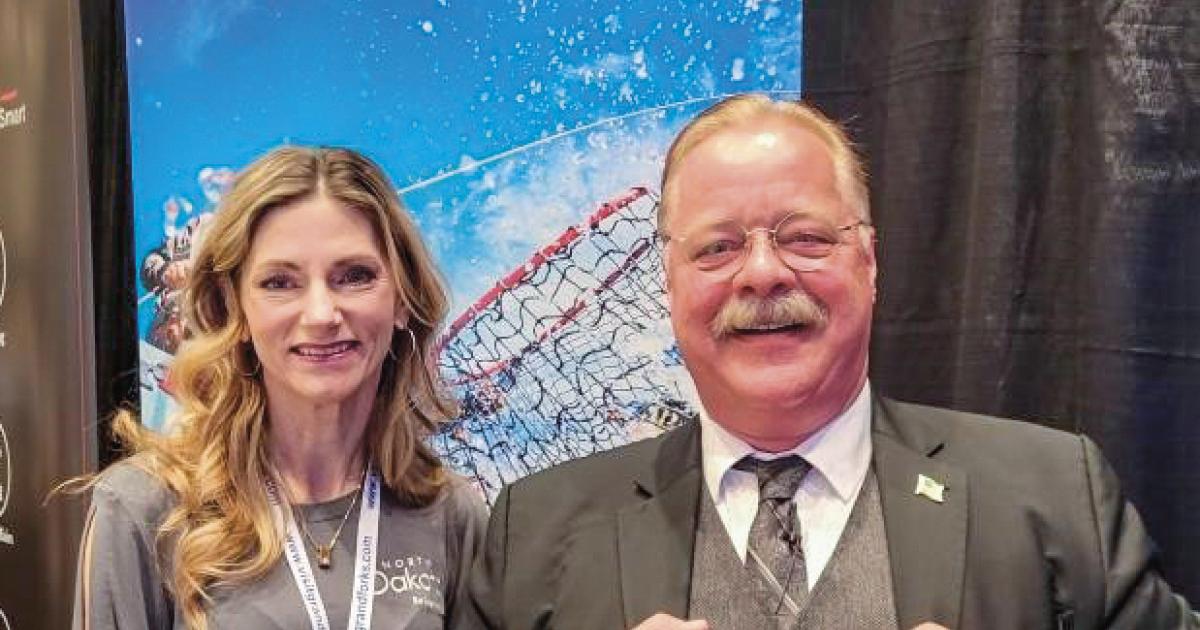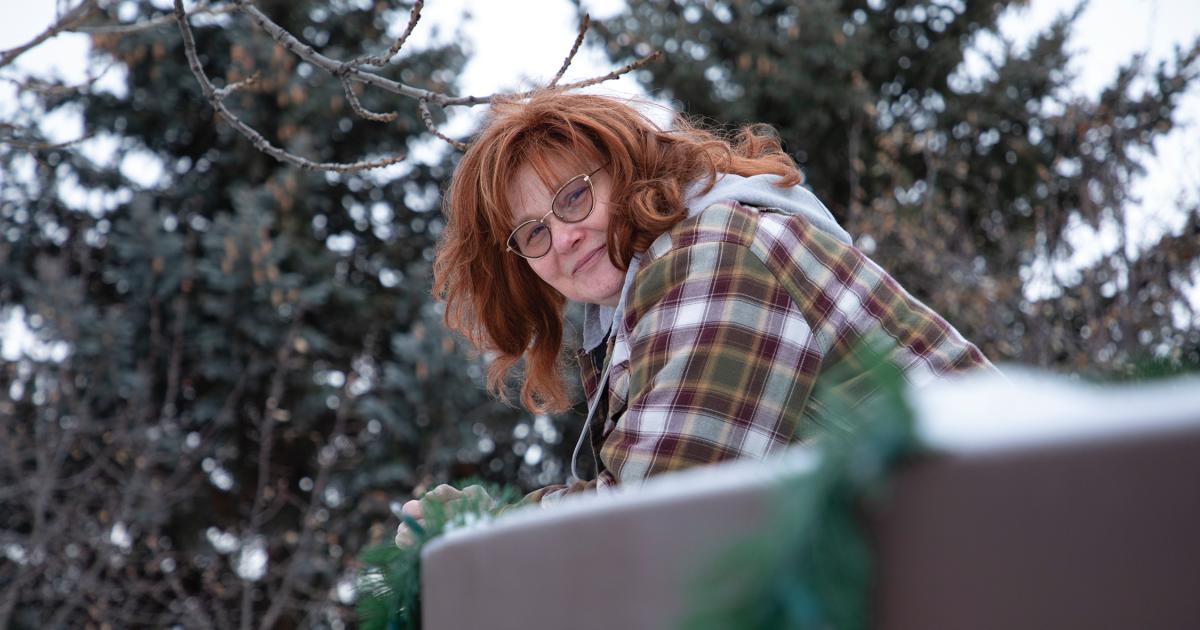Editor’s note: Due to COVID-19, the Kulm City Band has decided to celebrate its 126th anniversary in June 2021, rather than the 125th this summer. This decision was made after presstime. Supporters can expect a full schedule of performances from various bands and musicians next year, as the band marches from year 125 to 126.
When the Kulm community gathers once again, there will be a joyous sound. The Kulm City Band, a unique community band celebrating its 125th anniversary, will meld tubas and trumpets, piccolo and percussion once again.
“Originally, a lot of towns had city bands, and most of them went by the wayside, where our town has had it almost the whole time,” says the band’s current organizer, Wes Gackle, 69, who joined the band as an eighth-grader playing the trombone.
The Kulm City Band in 1949.
Formed in 1895, a mention of the city band was found in a Feb. 17, 1898, Kulm newspaper by local historian Jeff Malm. The article was about three Kulm men, Frank Coon, John H. George and Fred Buechler, leaving on the train for the gold fields of the Alaskan Klondike. It read: “Half the population of Kulm turned out and attended the boys to the depot and the band, of which Buechler was a member, discoursed inspiring music to give them heart for their enterprise.”
And band members have been playing with their hearts ever since.
Secret to longevity
The 2020 band features musicians from 13 years old to 93-year-old Bill Gackle, the band’s current elder statesman who began playing in his teens. Three generations of Gackles now sit on the band, including Bill, his son and two grandsons. Wes is another example of the longevity of the band, taking over managing the band from his father, Bob, who passed away in 2005.
While it’s a community band, members travel from Fargo, Edgeley, Wishek and Bismarck to participate, including alumni who return to play in summer concerts.
“Fun, fellowship and laughter have always been an integral part of the survival of the city band. However, the love of music and the expectation that it be played well have been the core values that have made this amateur group successful,” Harvey Lindgren wrote about the band.
“Kulm has always been a musical community and there’s a lot of pride in the city band. A number of us have just enjoyed participating in music,” Wes says. “There’s always been somebody who has felt like they needed to keep it going. There’s enough music interest that people are willing to take part, and you get that camaraderie. It’s fun performing and it’s also fun having the old alumni from the band or the school to come.”
The first uniforms – green with brass buttons and black braiding – were purchased in 1912, and a drum major was soon added. With the advent of World War I, the band was inactive for two years.
Legacy begins
In 1925, the Hollan legacy began, as the band was directed for more than 70 years by three Hollans, starting with Ed Hollan in 1925.
“He often commented that Monday evenings when the band would practice marching, and he was a precision instructor, the children who would follow the band skipping and having fun were often the youngsters who later marched in that band,” a history states.
Under Ed’s leadership, U.S. Sen. William Langer appointed the Kulm City Band as “The United States Senators’ Band” in the 1940s.
A Kulm Messenger article described Ed’s band playing at weddings, anniversaries and even traveling to other towns to support the Kulm baseball team. In an interview with The Jamestown Sun in 1972, Ed describes John Philip Sousa marches as “the greatest music there is.”
In 1973, Art Hollan, Ed’s nephew, became director. A graduate of the University of North Dakota with a major in music, he served as a clarinetist in the U.S. Army Band in Germany from 1953 to 1954. He taught high school band in Jud and directed the Kulm City Band until his death in 1986. Succeeding Art, still another Hollan, Curtis, held the baton, also teaching high school band in Minnesota and returning to practice with the Kulm band during the summers.
“Though farmers, ballplayers and teachers, the Hollan clan was best known as skilled musicians,” Lindgren wrote.
“It is said that in the drought and Depression days, when most families would gather for picnics and baseball, the Hollans would gather for picnics and band practice. This writer believes that to be true after attending a Sunday night in the park concert in the 1990s. Lee (Bobbie) Hollan (born in 1916) played his trumpet with gusto throughout the evening, while regularly drawing oxygen from the tank taped to his chair throughout the performance,” Lindgren wrote.
In about 1927, the band’s uniforms transitioned to navy blue capes with an over cape with a red satin lining and white caps.
“How well we remember that red satin lining. When they concluded a concert, the top cape would be buttoned back on one side. They were extremely warm, but the effect on parade was worth the suffering,” a history piece shared.
In 1957, the band went on a small-town tour, where “north of town, the road was so rough the 1946 Ford sort of hopped into the ditch. Somehow, the drums ended up floating in the water. Bill Gackle says they sounded as good as ever,” another history segment shares.
Wes Gackle remembers other moments with the band, including traveling to perform during North Dakota’s centennial in 1989, and camping with bandmates in tents along the Missouri River prior to a performance.
“The highlights were the performances, because people generally enjoy listening to bands like ours, so you get a lot of compliments,” he says.
Over its history, the band has performed at events ranging from community centennials to weddings to entertaining during community baseball games and pie socials at a locally known rural ballpark. On July 25-26, the LaMoure County Memorial Park near Grand Rapids will be celebrating its 100th anniversary. The Kulm City Band was at the opening of the park 100 years ago and hopes to return this year for the celebration.
Tradition continues
The band has evolved over the years, but still holds certain traditions. Members no longer march, but ride on a flatbed to play during parades. Weekly practices are no longer held year-round, but start in the spring to prepare for summer performances. But the band still focuses on playing marches, allowing alumni to pop into performances of familiar songs.
“Some of the music we’ve kept pretty constant over the years,” Wes says. “For a number of years, we really haven’t had a director. We just get started and go from there.”
During the summer, the band’s numbers swell to more than 30, with a wide range of instruments.
“It’s a nice sound, with woodwinds and brass,” Wes says.
“It’s a little different today than it was years ago. There wasn’t so much to do. Today, everybody is so busy, so we practice and get in some kind of shape and then have things going on in the summer to try to get people to play,” he says.
Several adult members of the Kulm City Band also share their talents by playing with the Kulm and Edgeley high school pep bands during the school year.
“Just to try and stay in some kind of shape. If you don’t play, it’s pretty tough to keep going,” Wes says.
The Kulm City Band has not only shared a joyful sound for 125 years, but has brought a musical community of all ages together.
“You’re amazed at some of these old guys, how well they can play,” Wes says. “It keeps relationships going, too. That’s the other thing that’s kind of neat.”
Luann Dart is a freelance writer and editor who lives in the Elgin area.












